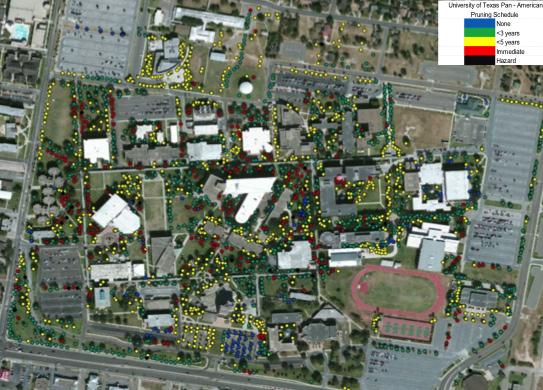
2 minute read
CAMPUS TREE CARE PLAN
G. GOALS AND TARGETS
All campus trees are inventoried every five years for quantity, health, and value. UTRGV Data Information Systems Center (DISC) worked with UTRGV’s biology department in assisting the urban forestry team to physically tag trees while recording GPS points for GIS mapping. Using the experience of the first tree inventory on the Edinburg campus, UTRGV’s goal is to expand the tree inventory process to other UTRGV campuses and subsidiary locations.
Advertisement
I. TREE INVENTORY
A digital tree inventory covering the core campus has been developed. When the data is placed on a web-based server, updates will be performed by the Assistant Director for Facilities Programs and Services, participating Forestry professor(s), or future designated campus arborist. Every five years, a tree inventory will be done. The inventory will be carried out in an interdisciplinary manner that will also work as a service learning project. A graduate student, approved by the Campus Tree Advisory Committee, will be chosen to lead a student work force to inventory the trees. As of September 2016, the data is stored locally on a Facilities Planning and Operations computer. The inventory may be used for campus planning purposes, tree management, academic and general public read-only access.
The inventory includes:
1. Tree species
2. Tree tag numbers
3. Maintenance types
4. Maintenance timeline
5. GPS points
6. Hazards
7. Priority Tasks
II. TREE CANOPY AND CAMPUS MASTER PLAN
Goal 1: In preparation for the upcoming student forestry course inventory, the goal is to increase and keep track of all new tree plantings on the Edinburg campus. We have increased and kept track of all new tree plantings on the Edinburg campus.
Goal 2: The addition of new community forestry member Allen Williams meets our goal of growing our advisory committee.
-We have increased advisory committee with a new student member(Damien Davila).
Goal 3: Continue with the plans of expanding the tree inventory program to our Brownsville campus. -We have expanded efforts of regional reforestation with two new programs/tree nurseries(1) om campus amnd the second off campus.
Goal 4: The donation from US Fish and Wildlife of (approx. 250) trees allowed UTRGV students to engage in the community and procure its involvement in keeping with the goal of expanding tree planting and care beyond the university grounds.
- We also added education and outreach within our new Sustainability Adelante Series featuring a Film “Intelligent Trees, (3) Podcast around Forestry Management and (2) Tik Tok videos regarding the benefits of Trees and why we should all plant more trees.
H. TREE DAMAGE ASSESSMENT
The tree inventory will assess the state of all trees on campus every five years. In case of sudden and widespread damage,higher profile trees are assessed by an outside consultant and assessment on low profile trees is performed via the Campus Tree Advisory Committee. Enforcement of protection measures is performed by project managers and on-site engineers.
a. In accordance with the budget, removed trees will be replaced to restore structure of the habitat.
b. If tree is of high value, replanting the tree in a new area should be considered.
c. Trees of low value, unsalvageable or of poor health should be removed.
I. PROHIBITED PRACTICES
I. BIKE LOCKING
Detailed UTRGV Department Parking and Transportation policies can be read here: http://www.utrgv.edu/_files/documentstransportation/utrgv-parking-rules-and-regulations.pdf a. Vehicles shall not park in a manner that inflicts damage to shrubbery, trees, grass, grounds or structures. b. Motorcycles, Motor Scooters, Mopeds and Motor- Assisted-Bicycles shall NOT be parked by or otherwise secured to trees. c. Bicycles MAY NOT be secured to any tree, shrub or plant. Bicycle racks are placed at strategic points on campus. d. Bicycles parked or secured to trees and landscaping will be immobilized or impounded.

J. COMMUNICATION STRATEGY
Currently, the tree protection guidelines are communicated to project managers for inclusion in to project specifications. The tree preservation categorizing process is used by the office of the University Architect for building siting and campus master planning. Upon official adoption, the plan will be shared by the Office for Sustainability (OFS) in an effort to educate the campus by utilizing all means of campus communication. Effective means of sharing information include the OFS website, the UTRGV community student newspaper, and links on the website of the Office of Facilities Planning and Operations.









